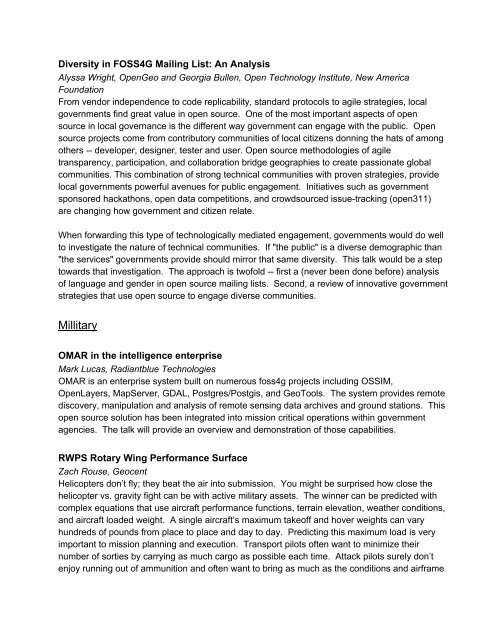FOSS4G North America Conference 2013 Preliminary Program
FOSS4G North America Conference 2013 Preliminary Program
FOSS4G North America Conference 2013 Preliminary Program
You also want an ePaper? Increase the reach of your titles
YUMPU automatically turns print PDFs into web optimized ePapers that Google loves.
Diversity in <strong>FOSS4G</strong> Mailing List: An Analysis<br />
Alyssa Wright, OpenGeo and Georgia Bullen, Open Technology Institute, New <strong>America</strong><br />
Foundation<br />
From vendor independence to code replicability, standard protocols to agile strategies, local<br />
governments find great value in open source. One of the most important aspects of open<br />
source in local governance is the different way government can engage with the public. Open<br />
source projects come from contributory communities of local citizens donning the hats of among<br />
others developer, designer, tester and user. Open source methodologies of agile<br />
transparency, participation, and collaboration bridge geographies to create passionate global<br />
communities. This combination of strong technical communities with proven strategies, provide<br />
local governments powerful avenues for public engagement. Initiatives such as government<br />
sponsored hackathons, open data competitions, and crowdsourced issuetracking (open311)<br />
are changing how government and citizen relate.<br />
When forwarding this type of technologically mediated engagement, governments would do well<br />
to investigate the nature of technical communities. If "the public" is a diverse demographic than<br />
"the services" governments provide should mirror that same diversity. This talk would be a step<br />
towards that investigation. The approach is twofold first a (never been done before) analysis<br />
of language and gender in open source mailing lists. Second, a review of innovative government<br />
strategies that use open source to engage diverse communities.<br />
Millitary<br />
OMAR in the intelligence enterprise<br />
Mark Lucas, Radiantblue Technologies<br />
OMAR is an enterprise system built on numerous foss4g projects including OSSIM,<br />
OpenLayers, MapServer, GDAL, Postgres/Postgis, and GeoTools. The system provides remote<br />
discovery, manipulation and analysis of remote sensing data archives and ground stations. This<br />
open source solution has been integrated into mission critical operations within government<br />
agencies. The talk will provide an overview and demonstration of those capabilities.<br />
RWPS Rotary Wing Performance Surface<br />
Zach Rouse, Geocent<br />
Helicopters don’t fly; they beat the air into submission. You might be surprised how close the<br />
helicopter vs. gravity fight can be with active military assets. The winner can be predicted with<br />
complex equations that use aircraft performance functions, terrain elevation, weather conditions,<br />
and aircraft loaded weight. A single aircraft’s maximum takeoff and hover weights can vary<br />
hundreds of pounds from place to place and day to day. Predicting this maximum load is very<br />
important to mission planning and execution. Transport pilots often want to minimize their<br />
number of sorties by carrying as much cargo as possible each time. Attack pilots surely don’t<br />
enjoy running out of ammunition and often want to bring as much as the conditions and airframe


